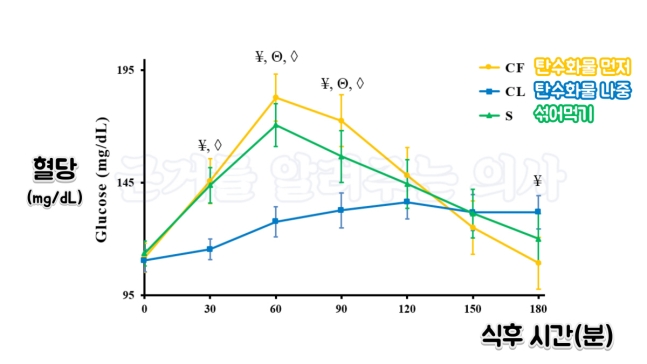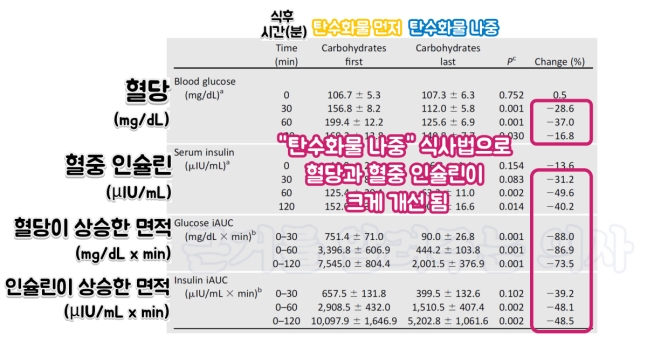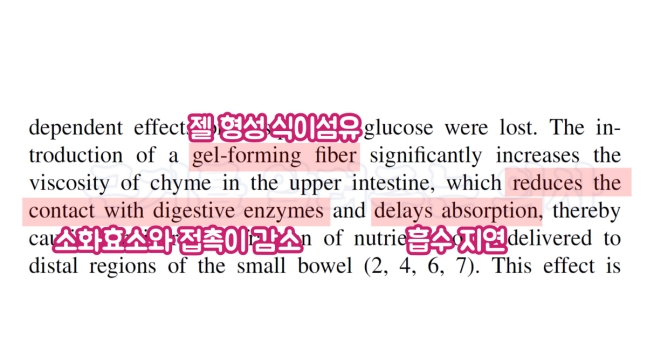Was it this easy? How to significantly lower post-meal blood sugar! Doctors share evidence-based tips.
2024.07.15 09:55
Views Likes Scraps

There are 6 million diabetes patients in Korea, and 15 million are in pre-diabetes stages, making it very common. Even young diabetes patients in their 20s and 30s are steadily increasing. Diabetes is extremely deadly to blood vessels and can cause complications such as diabetic retinopathy, which can lead to blindness, and diabetic nephropathy, which requires dialysis treatment. It is a serious disease that should not be taken lightly just because it is common. However, did you know that small changes in lifestyle habits can prevent and manage diabetes? Today, we will learn about the easiest method among them.
Today's quiz: Even if you eat the same food, following the proper order of meals can significantly reduce post-meal blood sugar levels.
The correct answer is O.
Core Evidence 1. The following is a study conducted on patients with type 2 diabetes who are being treated with metformin (diabetes medication). In this study, participants were given the same food, but the order of consuming vegetables (dietary fiber), protein, and carbohydrates was varied to observe changes in blood sugar levels. The experiment was divided into a total of three groups as follows.
1) The first group is "Carbohydrates First." They consume carbohydrates first, then, after 10 minutes, they consume vegetables and proteins.
2) The second group is 'Carbohydrates Later'. This group consumed vegetables and proteins first, followed by carbohydrates after 10 minutes.
3) The third group is 'mixing and eating.' It is a group that ate vegetables, proteins, and carbohydrates all together without any particular order.
The graph below shows the results of blood sugar measurements taken at 30-minute intervals after meals for each of the three groups.
Today's quiz: Even if you eat the same food, following the proper order of meals can significantly reduce post-meal blood sugar levels.
The correct answer is O.
Core Evidence 1. The following is a study conducted on patients with type 2 diabetes who are being treated with metformin (diabetes medication). In this study, participants were given the same food, but the order of consuming vegetables (dietary fiber), protein, and carbohydrates was varied to observe changes in blood sugar levels. The experiment was divided into a total of three groups as follows.
1) The first group is "Carbohydrates First." They consume carbohydrates first, then, after 10 minutes, they consume vegetables and proteins.
2) The second group is 'Carbohydrates Later'. This group consumed vegetables and proteins first, followed by carbohydrates after 10 minutes.
3) The third group is 'mixing and eating.' It is a group that ate vegetables, proteins, and carbohydrates all together without any particular order.
The graph below shows the results of blood sugar measurements taken at 30-minute intervals after meals for each of the three groups.

The "Carbohydrates First" group and the "Mixing" group experienced a rapid spike in blood sugar levels after meals, followed by a sharp decline, whereas the "Carbohydrates Last" group showed a gradual increase in blood sugar after meals and maintained a stable pattern. Additionally, when comparing blood sugar levels one hour after meals, the "Carbohydrates Last" group showed a 25.2% reduction compared to the "Mixing" group, and the area under the blood sugar curve from 0 to 180 minutes (the area of the time-blood sugar graph) decreased by as much as 44.1%, indicating a significant improvement in post-meal blood sugar control in diabetic patients.
Key Evidence 2. I will introduce another experiment similar to the previously discussed one. This experiment was also conducted on type 2 diabetes patients receiving metformin (a diabetes medication). Participants ate the same foods but changed the order of their meals at one-week intervals. During the first week, they followed a 'carbohydrate first' eating method, consuming carbohydrates first and then proteins and vegetables 15 minutes later. In the subsequent week, they ate using the opposite meal order, the 'carbohydrate last' method.
As a result, the 'Carbohydrates Later' eating method reduced post-meal blood sugar levels by 28.6% (at 30 minutes after eating), 36.7% (at 60 minutes), and 16.8% (at 120 minutes) compared to the 'Carbohydrates First' eating method. Furthermore, all measures including blood insulin levels, the area under the blood glucose curve, and the area under the insulin increase curve showed significant improvement, indicating that it is highly effective for diabetes management.
Key Evidence 2. I will introduce another experiment similar to the previously discussed one. This experiment was also conducted on type 2 diabetes patients receiving metformin (a diabetes medication). Participants ate the same foods but changed the order of their meals at one-week intervals. During the first week, they followed a 'carbohydrate first' eating method, consuming carbohydrates first and then proteins and vegetables 15 minutes later. In the subsequent week, they ate using the opposite meal order, the 'carbohydrate last' method.
As a result, the 'Carbohydrates Later' eating method reduced post-meal blood sugar levels by 28.6% (at 30 minutes after eating), 36.7% (at 60 minutes), and 16.8% (at 120 minutes) compared to the 'Carbohydrates First' eating method. Furthermore, all measures including blood insulin levels, the area under the blood glucose curve, and the area under the insulin increase curve showed significant improvement, indicating that it is highly effective for diabetes management.

When you eat dietary fiber and protein first, your body prepares to absorb the carbohydrates you will eat afterward. Carbohydrates raise blood sugar, but when consumed in this prepared state, the fluctuations in blood sugar are reduced. Additionally, just by eating dietary fiber and protein first, the rate of stomach emptying is delayed, and the absorption rate of carbohydrates also slows down, causing blood sugar to rise more gradually.
Even when eating the same food, blood sugar control can be achieved through an easy method called adjusting the order of meals. Considering that Koreans have a smaller pancreas that secretes insulin and are more genetically predisposed to diabetes, even if they do not currently have diabetes, they can prevent it by following a meal method called 'food + protein -> 10 carbohydrate' where 1) dietary fiber and protein are eaten first during meals, and 2) carbohydrates are consumed 10-15 minutes later. This approach can delay the onset of diabetes and reduce the duration of living with the disease. The longer one has diabetes, the higher the risk of developing serious diabetic complications. Conversely, shortening the duration of diabetes can reduce the likelihood of complications.
Bonus information. There are many research findings indicating that dietary fiber helps improve blood sugar control. In particular, among dietary fibers, gel-forming fibers like psyllium husk, which form a gel when meeting water, are most effective in lowering post-meal blood sugar levels. For reference, increasing dietary fiber intake in diabetic patients also reduces mortality from cardiovascular diseases, so it is important to consistently consume sufficient amounts of any type of dietary fiber regularly.
Even when eating the same food, blood sugar control can be achieved through an easy method called adjusting the order of meals. Considering that Koreans have a smaller pancreas that secretes insulin and are more genetically predisposed to diabetes, even if they do not currently have diabetes, they can prevent it by following a meal method called 'food + protein -> 10 carbohydrate' where 1) dietary fiber and protein are eaten first during meals, and 2) carbohydrates are consumed 10-15 minutes later. This approach can delay the onset of diabetes and reduce the duration of living with the disease. The longer one has diabetes, the higher the risk of developing serious diabetic complications. Conversely, shortening the duration of diabetes can reduce the likelihood of complications.
Bonus information. There are many research findings indicating that dietary fiber helps improve blood sugar control. In particular, among dietary fibers, gel-forming fibers like psyllium husk, which form a gel when meeting water, are most effective in lowering post-meal blood sugar levels. For reference, increasing dietary fiber intake in diabetic patients also reduces mortality from cardiovascular diseases, so it is important to consistently consume sufficient amounts of any type of dietary fiber regularly.

Today's conclusion,
1. The "Meal + Protein -> 10 Carbohydrates" eating method, which involves eating dietary fiber and protein first, then consuming carbohydrates after 10-15 minutes, slows the rise of post-meal blood sugar and reduces blood sugar spikes in diabetic patients.
2. Even if you are not a diabetic patient, changing the order of meals can prevent diabetes, and in this case, even if diabetes develops later, it can delay the onset and reduce the likelihood of diabetic complications.
3. Among dietary fibers, gel-forming types (such as psyllium husk) are the most effective for managing post-meal blood sugar levels.
4. Diabetic patients should consistently consume enough dietary fiber because increasing dietary fiber intake alone can reduce the mortality rate from cardiovascular diseases.
1. The "Meal + Protein -> 10 Carbohydrates" eating method, which involves eating dietary fiber and protein first, then consuming carbohydrates after 10-15 minutes, slows the rise of post-meal blood sugar and reduces blood sugar spikes in diabetic patients.
2. Even if you are not a diabetic patient, changing the order of meals can prevent diabetes, and in this case, even if diabetes develops later, it can delay the onset and reduce the likelihood of diabetic complications.
3. Among dietary fibers, gel-forming types (such as psyllium husk) are the most effective for managing post-meal blood sugar levels.
4. Diabetic patients should consistently consume enough dietary fiber because increasing dietary fiber intake alone can reduce the mortality rate from cardiovascular diseases.
0
0
Comments 3